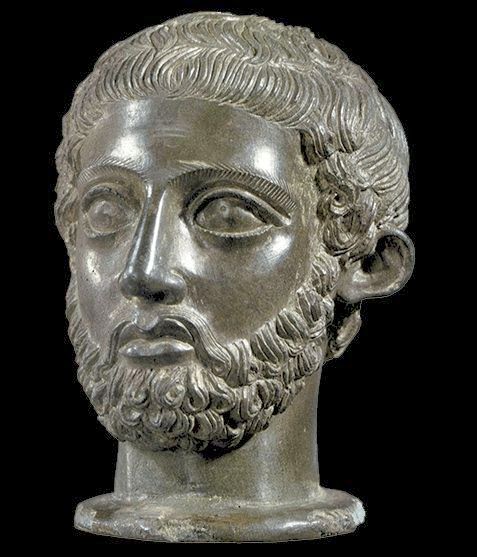Etruscan Enchantment. From the secrets of Holkham Hall to the wonders of the British Museum.
Palazzo Casali, Cortona. 22 March through 31 July 2014.
Cortona was one of the cities making up the Etruscan Dodecapoli league and parts of the Etruscan walls and gateways, as well as several Etruscan tombs are still to be seen there. In 1727, inspired by the publication of Dempster's De Etruria Regali, the Etruscan Academy was founded in Cortona by three brothers, Marcello, Filippo and Ridolfino Venuti. With the foundation of a museum that houses splendid Etruscan artifacts, the Etruscan Academy of Cortona became the first institution in Europe that specialised in the rediscovery and study of the Etruscans. In 2005, the museum was doubled in size to become the Museum of the Etruscan Academy and of the City of Cortona (MAEC). |
| Etruscan terracotta head from the Etruscan exhibition in Cortona, March through July 2014 |
During the second quarter of 2014, there is an excellent exhibition devoted to the Etruscans taking place at MAEC in Cortona. This exhibition, Etruscan Enchantment. From the secrets of Holkham Hall to the wonders of the British Museum, was inspired by recent archival finds related to the Grand Tour of Thomas William Coke, 1st Earl of Leicester (1754 – 1842). During the first years of the 18 C., Coke, known as Coke of Norfolk or Coke of Holkham and who later became an immensely popular MP and an agricultural reformer, was sent on the Grand Tour by his father and his great-aunt. The latter offered him £500 to not go to university, which she regarded as a den of vice, and he used the money to finance his tour.
 |
| Bronze masterpiece of Etruscan art at the Cortona exhibition |
Coke was entranced by the Etruscan artifacts that he saw in Italy, both in public displays and private collections. Upon his return to England, he organised and paid for the publication, in 1726, of the manuscript De Etruria Regali by Thomas Dempster (1579 – 1625). A century earlier, Dempster had been the first to assemble a history of the Etruscan people, creating the first “handbook of Etruscology” and summarising everything that was known about Etruscan civilisation up to that time. Dempster was a Cambridge-educated and very quarrelsome Scotch aristocrat. Recommended by Pope Paul V, who had previously incarcerated him as a spy (which he probably was), Dempster eventually found refuge and patronage under Grand Duke Cosimo II. The latter made him a professor in Pisa and commissioned his work on the Etruscans. After three years of intense research, Dempster presented Cosimo with his magnum opus, the manuscript of De Etruria Regali Libri Septem, "Seven Books about Royal Etruria", written in Latin. It was considered a brilliant work by all who saw it.
 |
| Etruscan bronze portrait bust |
 |
| Etruscan ceramic from the Cortona exhibition |
The exhibition recreates the atmosphere of excitement that followed the publication of De Etruria, and documents the role of the Grand Tour to Italy in the 18 C and 19 C, and the fascination with the Etruscans and the Etruscan style in Britain during that period. It presents to the public for the first time ever some iconic masterpieces of that ancient people - such as the Aule Metele and the Graziani Putto - alongside the original drawings for De Etruria as well as the Etruscan masterpieces gathered together by the British Museum during the course of three centuries. Many of these Etruscan artifacts are wonderful works of art in their own right, and displayed together form a show that should not be missed.
Exhibition website.
The Etruscans – who were they and where did they come from?
 |
| www.bella-toscana.com |
All content copyright © ammonet Italian Web Site Promotion 2014. All rights reserved.